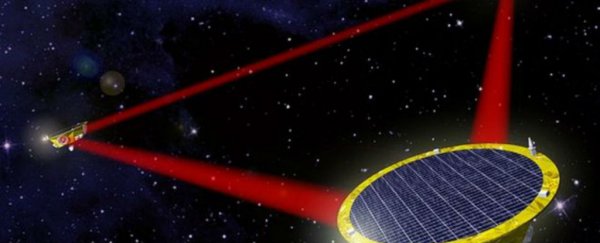Back in February, physicists set the world on fire (not literally) with the announcement of the first direct evidence of the gravitational waves that Einstein predicted more than 100 years ago.
It was a massive achievement - one that you'd definitely get tattooed on your arm if you were in any way involved - but now scientists want to take things a whole lot further. They want to spend around US$1.3 billion to get a new space-based observatory into orbit by 2029, so we can detect gravitational waves a whole lot closer to the source.
Why is it worth such an astronomical (sorry) amount of money to study gravitational waves from out in space, rather than on Earth?
Well, the twin LIGO (Laser Interferometer Gravitational-wave Observatory) detectors, located in Louisiana and Washington, did a great job at detecting the first-ever direct evidence of gravitational waves, but with one big limitation - they're not powerful enough to probe anywhere near the actual source.
"Currently, gravitational wave observatories possess relatively blurry vision," NASA explains, adding that LIGO scientists were only able to trace the source of the gravitational waves detected on 14 September 2015 to an arc of sky spanning an area of about 600 square degrees - about the angular area on Earth occupied by the entire United States.
That area has since been narrowed down by new data coming from NASA's space-based Fermi Gamma-ray Space Telescope, and that's exactly the point - if we want to get to know gravitational waves properly, we need to go to where they live.
And according to a new report, the European Space Agency's (ESA) proposed mission to get a new gravitational waves observatory into space is not just technically feasible - it's also really freaking compelling.
As Jonathan Amos reports for BBC News, the ESA recently asked a panel of experts called to perform a "sanity check" on the project, which is expected to cost well over 1 billion euros (US$1.3 billion).
Called the Gravitational Observatory Advisory Team (or Goat), the expert panel announced that it sees no major hurdles in the proposed plan, and even went so far as to recommend that the launch date be brought forward from 2034 to 2029.
It's a pretty good day when the people you request a sanity check from tell you you're being too cautious.
"[A]fter submitting our report, ESA came back to us and asked what we thought might be technically possible, putting aside the money," Goat chairman Michael Perryman told the BBC. "We are in the process of finalising a note on that, which will suggest the third quarter of 2029. So, 13 years from now."
Amos reports that the ESA is now expected to issue a call to the scientific community to submit a detailed proposal in the coming weeks.
So what would this space-based observatory actually do to detect the ripples in space-time caused by gravitational waves? The Goat scientists advise that it should take the same approach as LIGO did here on Earth, called laser interferometry.
"The LIGO laboratory works by bouncing lasers back and forth in two 4-km-long pipes, allowing physicists to measure incredibly small changes in spacetime," Fiona MacDonald explained for us back in February. "[T]his light is bounced back and forth by a set of mirrors. Any tiny ripples in spacetime will cause slight timing changes in this laser light, and the LIGO detectors are able to pick that up."
Essentially, the ESA would use the same technique for the new observatory, but this time, we'd be firing the lasers out in space.
One thing that makes ESA's whole mission that much more feasible is the fact that it already has a satellite out in orbit that's doing 'practice runs' of the kinds of experiments that a larger space-based observatory would need to conduct.
Launched on 3 December 2015, the LISA Pathfinder will not directly search for gravitational waves, but will test several new technologies that will be useful for such a mission.
"The agency is currently doing experiments in orbit that will prove some of the equipment needed on a future gravitational wave observatory," Amos reports for the BBC. "But the Goat also identifies critical additional developments that must now be prioritised to take the laser approach into space."
Only time will tell if the ESA will manage to gather together all the funds in time, but we sure hope it does. Because it's not every day that a big, crazy, moonshot idea like putting an entire observatory out in space in just over a decade gets the "Hell yeah, it's practical!" stamp of approval. Let's not waste it.
